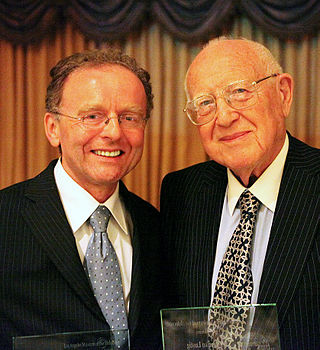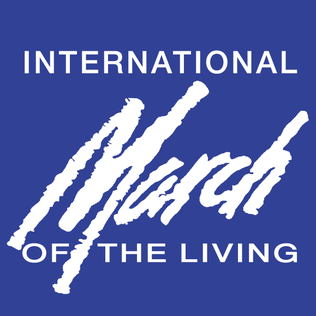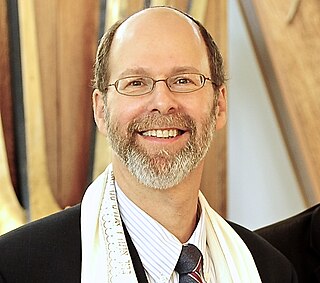Related Research Articles

Yom HaZikaron laShoah ve-laG'vurah, known colloquially in Israel and abroad as Yom HaShoah and in English as International Holocaust Remembrance Day, or Holocaust Day, is observed as Israel's day of commemoration for the approximately six million Jews murdered in the Holocaust by Nazi Germany and its collaborators, and for the Jewish resistance in that period. In Israel, it is a national memorial day. The first official commemorations took place in 1951, and the observance of the day was anchored in a law passed by the Knesset in 1959. It is held on the 27th of Nisan, unless the 27th would be adjacent to the Jewish Sabbath, in which case the date is shifted by a day.

The United States Holocaust Memorial Museum (USHMM) is the United States' official memorial to the Holocaust. Adjacent to the National Mall in Washington, D.C., the USHMM provides for the documentation, study, and interpretation of Holocaust history. It is dedicated to helping leaders and citizens of the world confront hatred, prevent genocide, promote human dignity, and strengthen democracy.
A Holocaust memorial day or Holocaust remembrance day is an annual observance to commemorate the victims of the Holocaust, the genocide of six million Jews and of millions of other Holocaust victims by Nazi Germany and its collaborators. Many countries, primarily in Europe, have designated national dates of commemoration. In 2005, the United Nations instituted an international observance, International Holocaust Remembrance Day.

Gedenkdienst is the concept of facing and taking responsibility for the darkest chapters of one's own country's history while ideally being financially supported by one's own country's government to do so. Founded in Austria in 1992 by Andreas Maislinger, the Gedenkdienst is an alternative to Austria's compulsory national military service as well as a volunteering platform for Austrians to work in Holocaust and Jewish culture-related institutions around the world with governmental financial support. In Austria it is also referred to as Austrian Holocaust Memorial Service provided by the Austrian Service Abroad. The Austrian Gedenkdienst serves the remembrance of the crimes of Nazism, commemorates its victims and supports Jewish cultural future. The program is rooted in the acknowledgment of responsibility by the Austrian government for the crimes committed by National Socialism.

The March of the Living is an annual educational program which brings students from around the world to Poland, where they explore the remnants of the Holocaust. On Holocaust Memorial Day observed in the Jewish calendar, thousands of participants march silently from Auschwitz to Birkenau, the largest Nazi concentration camp complex built during World War II.

The International Holocaust Remembrance Day, or the International Day in Memory of the Victims of the Holocaust, is an international memorial day on 27 January that commemorates the victims of the Holocaust, which resulted in the genocide of one third of the Jewish people, along with countless members of other minorities by Nazi Germany between 1933 and 1945, an attempt to implement its "final solution" to the Jewish question. 27 January was chosen to commemorate the date when the Auschwitz concentration camp was liberated by the Red Army in 1945.

Holocaust survivors are people who survived the Holocaust, defined as the persecution and attempted annihilation of the Jews by Nazi Germany and its allies before and during World War II in Europe and North Africa. There is no universally accepted definition of the term, and it has been applied variously to Jews who survived the war in German-occupied Europe or other Axis territories, as well as to those who fled to Allied and neutral countries before or during the war. In some cases, non-Jews who also experienced collective persecution under the Nazi regime are considered Holocaust survivors as well. The definition has evolved over time.

The Holocaust had a deep effect on society both in Europe and the rest of the world, and today its consequences are still being felt, both by children and adults whose ancestors were victims of this genocide.
Benjamin Meed, a Polish Jew, fought in the Warsaw ghetto underground, served on the Advisory Board of the President's Commission on the Holocaust, planned the 1981 World Gathering of Jewish Holocaust Survivors and the 1983 American Gathering of Jewish Holocaust Survivors held in Washington, D.C., and other reunions that followed, and was President of the American Gathering of Jewish Holocaust Survivors and their Descendants.
United Nations General Assembly resolution 60/7 on Holocaust remembrance called for the establishment of a programme of outreach on the subject of the "Holocaust and the United Nations" and measures to mobilize civil society for Holocaust remembrance and education, in order to help to prevent future acts of genocide. Since its establishment by the Department of Public Information in January 2006, the Holocaust and the United Nations Outreach Programme has developed an international network of civil society groups and a multi-faceted programme that includes: innovative online educational products, youth outreach, DVDs, seminars and training programmes, a film series, book signings, a permanent exhibit at United Nations Headquarters in New York City, and the annual worldwide observance of the International Day of Commemoration in memory of the victims of the Holocaust.
A "survivor registry" is a database or list of individuals who have survived a particular event or situation, such as a natural disaster, a disease outbreak, or a war. The purpose of a survivor registry is to identify and track individuals who have survived the event and to provide information about their status, whereabouts and needs. Individuals, organizations and agencies use survivor registries to provide support and assistance to survivors, o reunite families and acquaintances re-establish contact after they have been separated by the disruption caused by the disaster, and to track and respond to any long-term needs or effects of the event.

The Days of Remembrance of the Victims of the Holocaust (DRVH) is an annual eight-day period designated by the United States Congress for civic commemorations and special educational programs that help citizens remember and draw lessons from the Holocaust. The annual DRVH period normally begins on the Sunday before the Israeli observance of Yom HaShoah, Holocaust Memorial Day, and continues through the following Sunday, usually in April or May. A National Civic Commemoration is held in Washington, D.C., with state, city, and local ceremonies and programs held in most of the fifty states, and on U.S. military ships and stations around the world. The United States Holocaust Memorial Museum designates a theme for each year's programs, and provides materials to help support remembrance efforts.

Vladka Meed was a member of Jewish resistance in Poland who famously smuggled dynamite into the Warsaw Ghetto, and also helped children escape out of the Ghetto.
Elizabeth Ester Jaranyi was a survivor of Nazi concentration camps during the Holocaust and the memorist of The Flowers From My Mother's Garden.
Hidden children during the Holocaust were the children who were hidden in various different ways during the Holocaust, in order to save them from the Nazis. Most were hidden in Poland, though some were hidden in Western Europe. Not all attempts to save them were successful; for instance, Anne Frank was eventually captured in Amsterdam.

Miriam Weiner is an American genealogist, author, and lecturer who specializes in the research of Jewish roots in Poland and the former Soviet Union. Weiner is considered to be one of the pioneers of contemporary Jewish genealogy through her work to open up archives and is described as a trail-blazing, highly respected guide and leading authority on archival holdings and resources in pre-war Belarus, Lithuania, Moldova, Poland, and Ukraine.

Eli Rubenstein is a Holocaust educator, writer, and filmmaker. He is currently the religious leader of Congregation Habonim Toronto, a Toronto synagogue founded by Holocaust survivors. He is also the National Director of March of the Living Canada, Director of Education for March of the Living International, Director of March of Remembrance and Hope Canada, and Chairman of the Canadian Friends of the Israel Guide Dog Center for the Blind.
Sigmund Strochlitz was a Polish-born Jewish American entrepreneur, political activist, and Holocaust survivor. He served on the U.S. President's Commission on the Holocaust and the U.S. Holocaust Memorial Council from 1978 to 1986, establishing the United States Holocaust Memorial Museum. Strochlitz was the first chair of the council's Days of Remembrance committee, persuading state and federal officials to hold annual Holocaust commemorations in all fifty state capitals and in Washington, D.C. in 1985 and every year since. According to the Encyclopedia Judaica, Strochlitz was a "major figure in institutionalizing Holocaust commemoration" throughout the United States.

Bina Landau was a Polish-born American Soprano folk and art singer active from the 1950s to the 1970s. She primarily performed in Yiddish and Hebrew, interpreting the work of such composers and poets as Itzik Manger, Hayim Nahman Bialik, and Mordechai Gebirtig. She was a Holocaust survivor, having been imprisoned in Bergen-Belsen and other camps during the Second World War.

Edward Mosberg was a Polish-American Holocaust survivor, educator, and philanthropist. During the Holocaust, he was held by the Nazis from 14 years of age in Kraków Ghetto, Kraków-Płaszów concentration camp, Auschwitz concentration camp, Mauthausen concentration camp, and a slave labor camp in Linz, Austria, that was liberated by the US Army in 1945. Nearly all of his family were murdered in the Holocaust.
References
- 1 2 Berger, Joseph (24 November 2012). "Vladka Meed, Who Infiltrated Warsaw Ghetto, Dies at 90". The New York Times . Retrieved 16 May 2015.
- ↑ Brozan, Nadine (15 June 1981). "Holocaust Survivors on 'Pilgrimage of Rememberance(sic)'". The New York Times. Retrieved 16 May 2015.
- ↑ Miller, Stephen (26 October 2006). "Benjamin Meed, 88, Organized Holocaust Survivors". New York Sun . Retrieved 16 May 2015.
- ↑ Trausch, Susan (10 April 1983). "Holocaust Survivors Gather to Piece the Puzzle Together". The Boston Globe . ISSN 0743-1791. ProQuest 294115949.(subscription required)
- ↑ American Gathering of Holocaust Survivors (1985). From Holocaust to New Life: A Documentary Volume Depicting the Proceedings and Events of the American Gathering of Jewish Holocaust Survivors, Washington DC, April 1983–Nissan 5743. New York, NY: American Gathering of Holocaust Survivors. OCLC 15069152.
- ↑ Fox, Margalit (26 October 2006). "Benjamin Meed, 88, Who Was a Key Advocate for Holocaust Survivors, Dies". The New York Times. Retrieved 16 May 2015.
- ↑ Miller, Judith (12 April 1983). "Holocaust Survivors, in U.S. Reunion, Ask World to Remember". The New York Times. Retrieved 16 May 2015.
- ↑ Reagan, Ronald (11 April 1983). "Remarks to the American Gathering of Jewish Holocaust Survivors". American Presidency Project. University of California Santa Barbara. Archived from the original on 4 March 2016. Retrieved 16 May 2015.
- ↑ Trausch, Susan (12 April 1983). "Holocaust Survivors Seek the Past in 45,000 Names". The Boston Globe. ISSN 0743-1791. ProQuest 294183638.(subscription required)
- ↑ "Survivors Registry". Museum of Jewish Heritage . Archived from the original on 8 April 2015. Retrieved 16 May 2015.
- ↑ Berenbaum, Michael (Forward) (1999). Weiner, Miriam; Ukrainian State Archives (in cooperation with); Moldovan National Archives (in cooperation with) (eds.). Jewish Roots in Ukraine and Moldova: Pages from the Past and Archival Inventories (PDF). Secaucus, NJ: Miriam Weiner Routes to Roots Foundation. pp. ix–x. ISBN 978-0-96-565081-6. OCLC 607423469.
- ↑ Meeks, Flori (9 October 2012). "Clear Lake man changes outlook on life after Holocaust study trip". Houston Chronicle . Retrieved 16 May 2015.
- ↑ Barnes, Tiye (21 June 2014). "Spanish River High School Teacher to Attend Holocaust Seminar". The Boca Raton Tribune. Retrieved 16 May 2015.